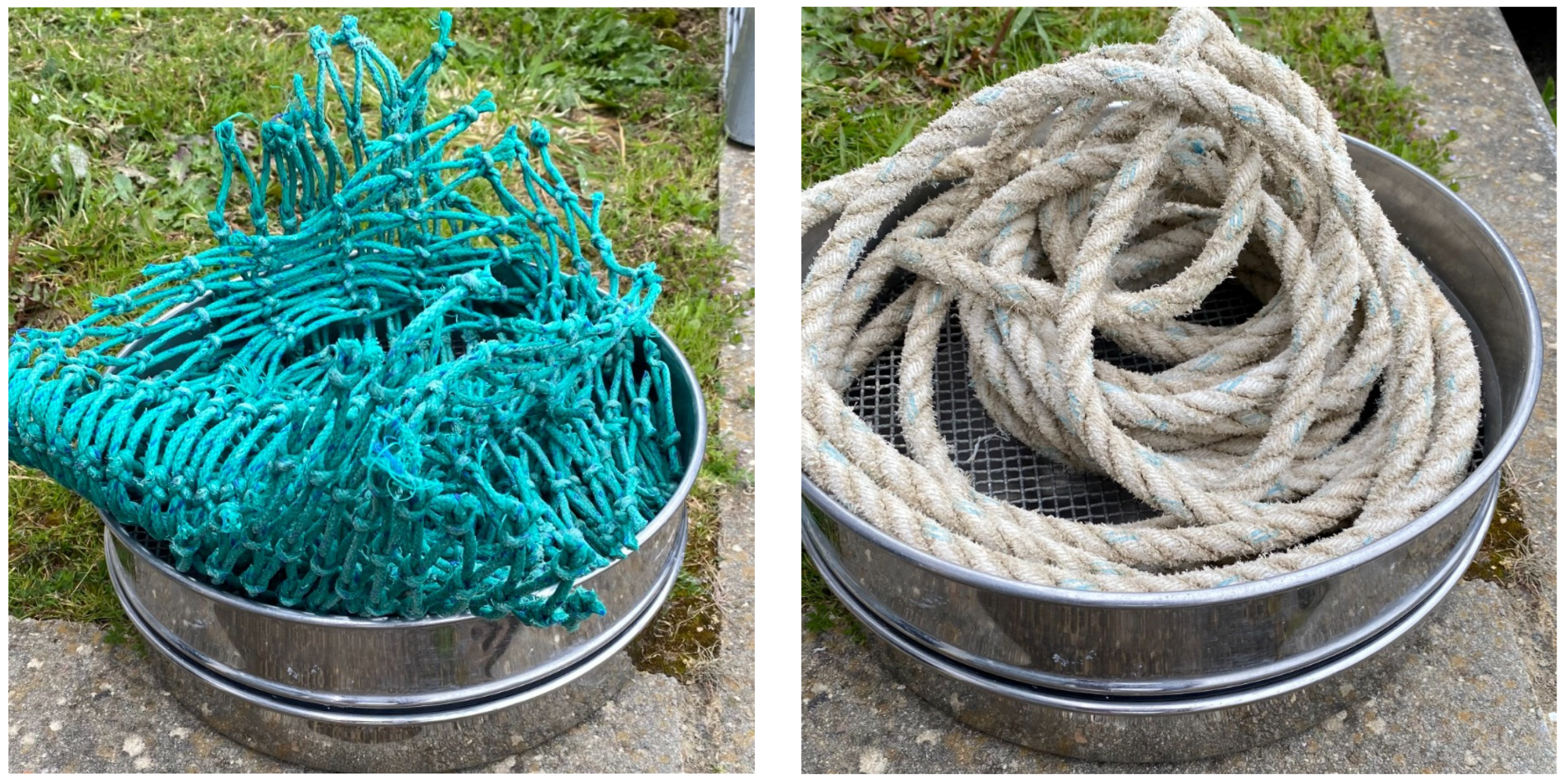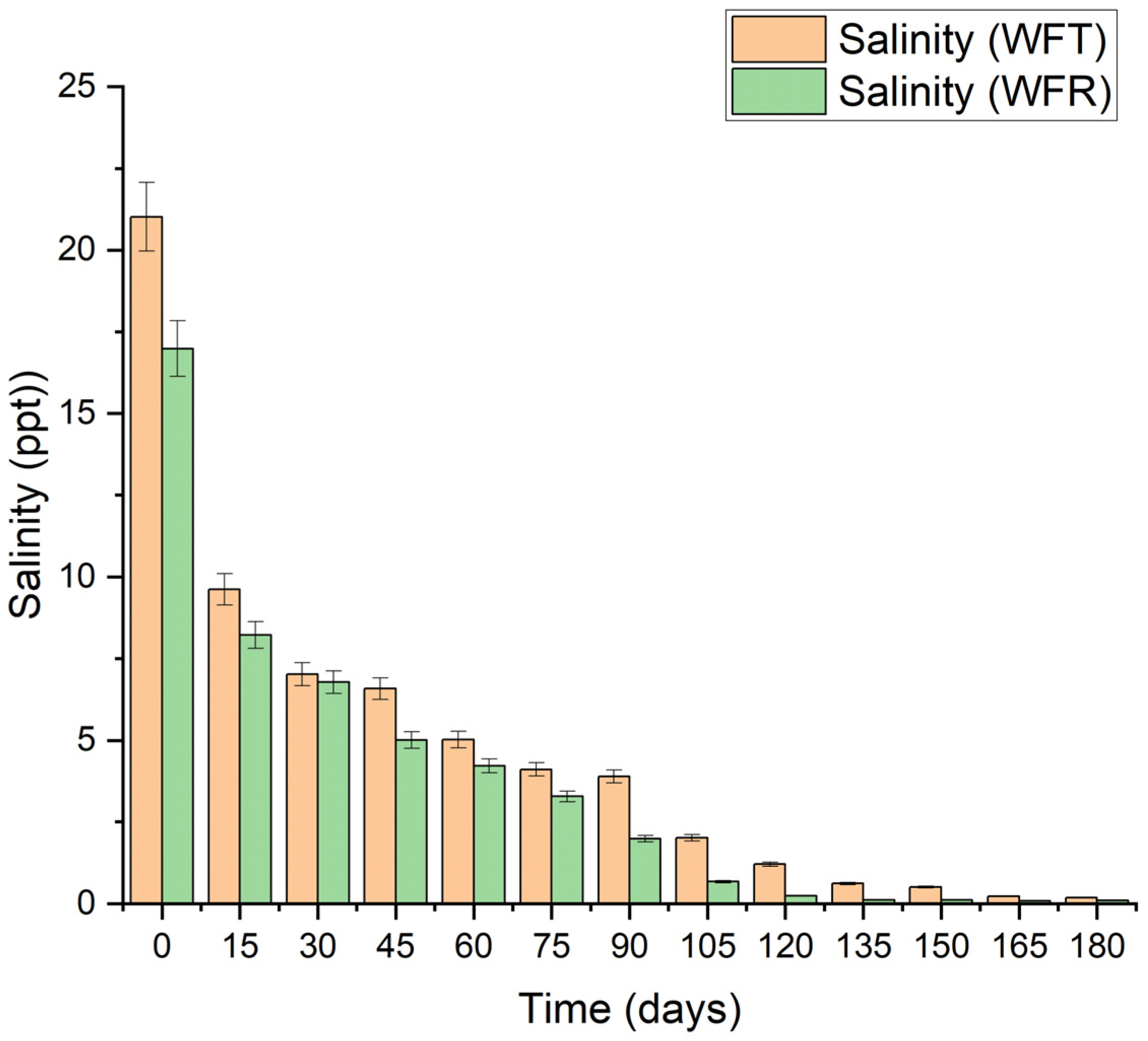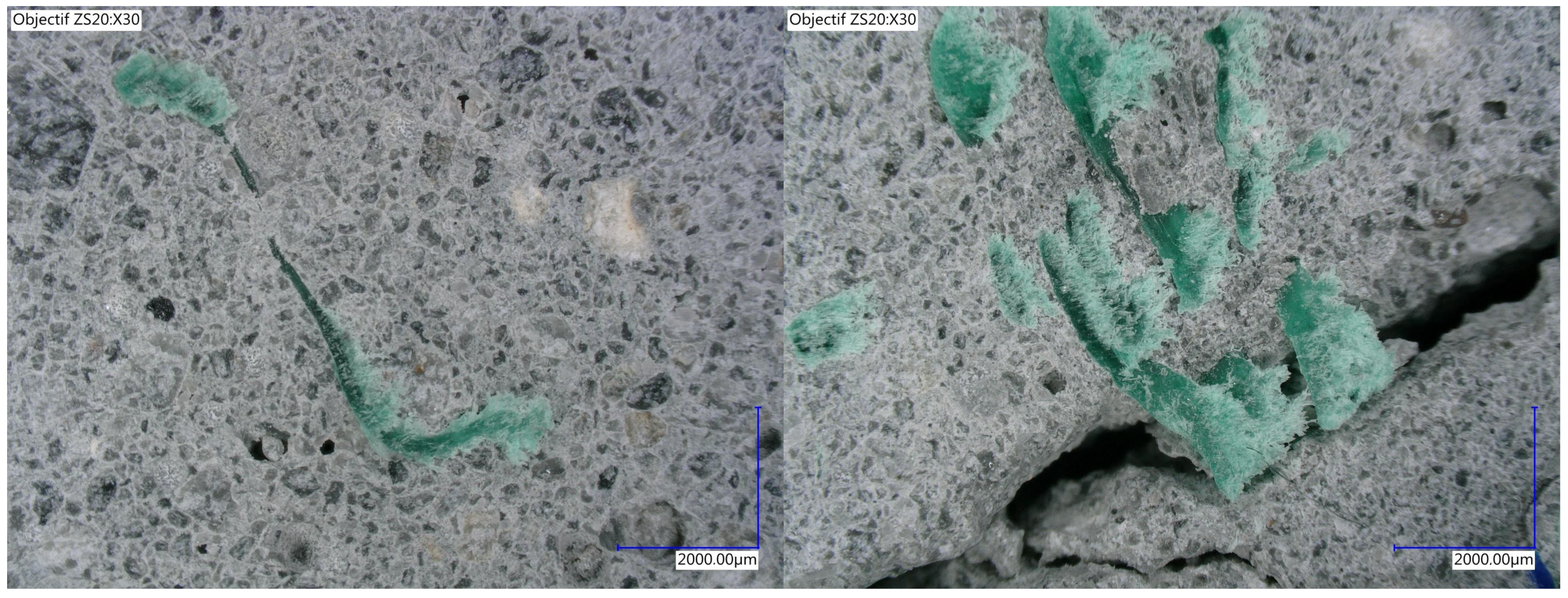Innovative Cutting and Valorization of Waste Fishing Trawl and Waste Fishing Rope Fibers in Cementitious Materials
Abstract
:1. Introduction
Research Significance
- As a means of mitigating environmental impacts, there is a vehement demand for recycling solutions for WFT and WFR.
- The mechanical behavior of recycled fiber-reinforced cementitious material, particularly recycled fiber from WFT and WFR, is still not very well-known.
- Most studies have focused on the mechanical properties of fiber-reinforced CM. Few discuss the cutting of these trawls and ropes into fibers.
- The increasing number of deteriorated concrete structures generates significant interest in the use of recycled fiber for concrete structure repair.
- Define the cleaning and cutting protocol for transforming WFT and WFR into fibers with an industrial perspective.
- To analyze the physical and mechanical properties of the WFT and WFR fibers before incorporating them in the CM.
- To study the use of polyethylene fibers obtained from WFT and polypropylene fibers from WFR for reinforcing the CM.
- Comprehend the impact of both kinds of fiber on the mechanical properties of CM.
- Determine the impact of fiber size and proportion on the characteristics of mortar in both its fresh and hardened states.
2. Materials and Methods
2.1. Materials
2.2. Methods
3. Results and Discussions
3.1. Optimization of Cleaning and Cutting of Fibers
3.2. Workability of Mortar Incorporating Fibers
3.3. Mechanical Properties in Hardened State
4. Discussion
- -
- The cutting mill enables accurate and efficient cutting of WFT and WFR into fibers, overcoming the constraints of manual techniques. The numerous sieve sizes of 4 mm, 8 mm, 10 mm, and 20 mm offer flexibility in collecting fibers of various lengths, enhancing the range of use.
- -
- Analysis of fiber size distribution shows that the cutting mill generates fibers that are predominantly centered around their respective sieve sizes. Smaller sieve sizes lead to narrower curves, showing less variation in fiber length. This knowledge is crucial for comprehending and managing the characteristics of the cementitious materials produced.
- -
- The natural cleaning process of WFT and WFR had favorable outcomes, as the salt content was effectively lowered to the target level over a period of 6 months when exposed to rain and wind. Despite the lengthy duration, the cleaning of WFT and WFR does not require any mechanical energy or manpower. Simply position them outside without any other requirements. However, mechanical cleaning remains a viable option in cases when the cleaning of WFT and WFR is time-sensitive and there is no room for delay. Nevertheless, it should be noted that this method would be inefficient and detrimental to the environment.
- -
- Studying how different fiber sizes and proportions affect the mechanical properties of CM is a critical part of the research. The study indicates that fibers acquired through a 20 mm sieve produce the best results when added to the cementitious material, and a fiber volume fraction of 0.5% yields the most advantageous effects. By augmenting the fiber concentration, clusters of fibers may form, leading to an increase in voids within the mortar and a subsequent decrease in its density. Figure 21a depicts the distribution of fiber that was added at a volume concentration of 0.5%. In contrast, the figure on the right illustrates the development of clusters after the fiber concentration was increased to 1%, which could be the cause of the reduction in the mechanical resistance of the mortar.
- -
- The workability of MC was affected differently by the presence of WFT and WFR fibers. The MC with WFT fibers showed a lesser reduction in workability compared to the MC with WFR fibers. Hence, the significance of fiber type in controlling the workability of the mortar is underscored. Furthermore, there was a direct correlation seen between the length of fibers and the decrease in workability. This highlights the need for conducting a comprehensive analysis of the fiber dimensions in order to properly address any possible difficulties associated with workability in CM. To address the problem of decreased workability, one might examine the selection of superplasticizer and the adjustment of the water/cement ratio. Nevertheless, using this method may lead to a decrease in mechanical characteristics. Hence, it is important to thoroughly investigate the optimal equilibrium among workability, water/cement ratio, and the use of superplasticizers. This might provide a novel study topic for future investigation.
- -
- The experiment shows a significant rise in porosity in CM when fibers are added. The results indicate that porosity shows a minor rise when fiber length increases, but a more significant increase is observed with larger fiber fractions. This trend highlights the balance needed between fiber proportion and porosity when optimizing the mechanical characteristics of the material.
5. Conclusions
Author Contributions
Funding
Institutional Review Board Statement
Informed Consent Statement
Data Availability Statement
Acknowledgments
Conflicts of Interest
References
- Macfadyen, G.; Huntington, T.; Cappell, R. Abandoned, Lost or Otherwise Discarded Fishing Gear (No. 523). Food and Agriculture Organization of the United Nations (FAO). 2009. Available online: https://www.cabidigitallibrary.org/doi/full/10.5555/20093147840/ (accessed on 5 May 2024).
- Ocean Voyages Institute. 2019. Available online: https://www.oceanvoyagesinstitute.org/ (accessed on 15 April 2024).
- Ronkay, F.; Molnar, B.; Gere, D.; Czigany, T. Plastic waste from marine environment: Demonstration of possible routes for recycling by different manufacturing technologies. Waste Manag. 2021, 119, 101–110. [Google Scholar] [CrossRef]
- Manfra, L.; Marengo, V.; Libralato, G.; Costantini, M.; De Falco, F.; Cocca, M. Biodegradable polymers: A real opportunity to solve marine plastic pollution? J. Hazard. Mater. 2021, 416, 125763. [Google Scholar] [CrossRef]
- Orasutthikul, S.; Unno, D.; Yokota, H. Effectiveness of recycled nylon fiber from waste fishing net with respect to fiber reinforced mortar. Constr. Build. Mater. 2017, 146, 594–602. [Google Scholar] [CrossRef]
- Srimahachota, T.; Yokota, H.; Akira, Y. Recycled nylon fiber from waste fishing nets as reinforcement in polymer cement mortar for the repair of corroded RC beams. Materials 2020, 13, 4276. [Google Scholar] [CrossRef]
- Park, J.K.; Kim, M.O.; Kim, D.J. Pullout behavior of recycled waste fishing net fibers embedded in cement mortar. Materials 2020, 13, 4195. [Google Scholar] [CrossRef]
- Recht, F. Fishing Gear Recycling and Disposal Options and Guidelines. Prepared for West Coast Governor’s Agreement on Ocean Health Derelict Fishing Gear Workshop. 2010. Pacific States Marine Fisheries Commission. Available online: https://www.coplare.net/app/download/5785465508/2010_USA_Fishing_Gear_Recycling+and+Disposal+Options+and+Guidelines.pdf (accessed on 5 May 2024).
- Coppola, D.; Lauritano, C.; Palma Esposito, F.; Riccio, G.; Rizzo, C.; de Pascale, D. Fish waste: From problem to valuable resource. Mar. Drugs 2021, 19, 116. [Google Scholar] [CrossRef]
- Juan, R.; Domínguez, C.; Robledo, N.; Paredes, B.; Galera, S.; García-Muñoz, R.A. Challenges and opportunities for recycled polyethylene fishing nets: Towards a circular economy. Polymers 2021, 13, 3155. [Google Scholar] [CrossRef]
- Kim, Y.T.; Kim, H.J.; Lee, G.H. Mechanical behavior of lightweight soil reinforced with waste fishing net. Geotext. Geomembr. 2008, 26, 512–518. [Google Scholar] [CrossRef]
- Srimahachota, T.; Matsuura, H.; Yokota, H. Mechanical Properties of Mortar Reinforced with Recycled Nylon Fiber from Waste Fishing Nets. In EASEC16: Proceedings of The 16th East Asian-Pacific Conference on Structural Engineering and Construction; Springer: Singapore, 2021. [Google Scholar] [CrossRef]
- Truong, V.D.; Kim, M.O.; Kim, D.J. Feasibility study on use of waste fishing nets as continuous reinforcements in cement-based matrix. Constr. Build. Mater. 2021, 269, 121314. [Google Scholar] [CrossRef]
- Park, J.K.; Kim, M.O. Mechanical properties of cement-based materials with recycled plastic: A review. Sustainability 2020, 12, 9060. [Google Scholar] [CrossRef]
- Bentur, A.; Mindess, S. Fibre Reinforced Cementitious Composites; CRC Press: Boca Raton, FL, USA, 2006. [Google Scholar] [CrossRef]
- Soroushian, P.; Khan, A.; Hsu, J.W. Mechanical properties of concrete materials reinforced with polypropylene or polyethylene fibers. Mater. J. 1992, 89, 535–540. [Google Scholar] [CrossRef]
- Armonico, A.; Michel, L.; Saidi, M.; Ferrier, E. Experimental Study on the Effect of Steel Reinforcement Ration on the Cracking Behaviour of FRP-Strengthened RC Elements. Buildings 2024, 14, 950. [Google Scholar] [CrossRef]
- Ma, L.; Sun, M.; Zhang, Y. The Mechanical and Self-Sensing Properties of Carbon Fiber-and Polypropylene Fiber-Reinforced Engineered Cementitious Composites Utilizing Environmentally Friendly Glass Aggregate. Buildings 2024, 14, 938. [Google Scholar] [CrossRef]
- Sahoo, P.P.; Singh, S.; Rout, P.K.; Mishra, S.; Das, A.P. Microbial remediation of plastic pollutants generated from discarded and abandoned marine fishing trawls. Biotechnol. Getrawlic Eng. Rev. 2022, 1–16. [Google Scholar] [CrossRef]
- Nelms, S.E.; Duncan, E.M.; Patel, S.; Badola, R.; Bhola, S.; Chakma, S.; Chowdhury, G.W.; Godley, B.J.; Haque, A.B.; Johnson, J.A.; et al. Riverine plastic pollution from fisheries: Insights from the Ganges River system. Sci. Total Environ. 2021, 756, 143305. [Google Scholar] [CrossRef]
- Bertelsen, I.M.G.; Ottosen, L.M. Recycling of waste polyethylene fishing trawls as fibre reinforcement in gypsum-based materials. Fibers Polym. 2021, 23, 164–174. [Google Scholar] [CrossRef]
- Spadea, S.; Farina, I.; Carrafiello, A.; Fraternali, F. Recycled nylon fibers as cement mortar reinforcement. Constr. Build. Mater. 2015, 80, 200–209. [Google Scholar] [CrossRef]
- Park, J.K.; Kim, D.J.; Kim, M.O. Mechanical behavior of waste fishing net fiber-reinforced cementitious composites subjected to direct tension. J. Build. Eng. 2021, 33, 101622. [Google Scholar] [CrossRef]
- Orasutthikul, S.; Yokota, H.; Hashimoto, K.; Unno, D. Effectiveness of Recycled Nylon Fibers in Mortar Comparing with Recycled PET and PVA Fibers. In Proceedings of the 4th International Conference on Sustainable Construction Materials and Technologies, Las Vegas, NV, USA, 7–11 August 2016; Available online: http://www.claisse.info/Proceedings.htm (accessed on 15 April 2024).
- Nguyen, T.N.; Han, T.H.; Park, J.K.; Kim, J.J. Strength and toughness of waste fishing net fiber-reinforced concrete. Materials 2021, 14, 7381. [Google Scholar] [CrossRef] [PubMed]
- Park, J.K.; Hong, K.N.; Choi, S.I.; Han, T.H.; Kim, M.O. Experimental study on strength and flexural toughness properties of waste fishing net hybrid fiber-reinforced cementitious composites. Compos. Struct. 2022, 295, 115833. [Google Scholar] [CrossRef]
- Zeyad, A.M.; Khan, A.H.; Tayeh, B.A. Durability and strength characteristiRc of high-strength concrete incorporated with volcanic pumice powder and polypropylene fibers. J. Mater. Res. Technol. 2020, 9, 806–813. [Google Scholar] [CrossRef]
- González-Aviña, J.V.; Juárez-Alvarado, C.A.; Terán-Torres, B.T.; Mendoza-Rangel, J.M.; Durán-Herrera, A.; Rodríguez-Rodríguez, J.A. Influence of fibers distribution on direct shear and flexural behavior of synthetic fiber-reinforced self-compacting concrete. Constr. Build. Mater. 2022, 330, 127255. [Google Scholar] [CrossRef]
- Zhang, P.; Li, Q.F. Effect of polypropylene fiber on durability of concrete composite containing fly ash and silica fume. Compos. Part B Eng. 2013, 45, 1587–1594. [Google Scholar] [CrossRef]
- Ozger, O.; Girardi, F.; Giannuzzi, G.; Salomoni, V.; Majorana, C.; Fambri, L.; Baldassino, N.; Di Maggio, R. Effect of nylon fibres on mechanical and thermal properties of hardened concrete for energy storage systems. Mater. Des. 2013, 51, 989–997. [Google Scholar] [CrossRef]
- Karahan, O.; Atiş, C.D. The durability properties of polypropylene fiber reinforced fly ash concrete. Mater. Des. 2011, 32, 1044–1049. [Google Scholar] [CrossRef]
- The Pew Charitable Trusts and SYSTEMIQ. Breaking the Plastic Wave: A Comprehensive Assessment of Pathways towards Stopping Ocean Plastic Pollution; SYSTEMIQ Ltd.: London, UK; Munich, Germany; Jakarta, Indonesia, 2020; Available online: https://www.systemiq.earth/ (accessed on 15 April 2024).
- Tiwari, P.; Chandak, R.; Yadav, R.K. Effect of salt water on compressive strength of concrete. Int. J. Eng. Res. Appl. 2014, 4, 38–42. [Google Scholar]
- Zhou, Y.; Xiao, Y.; Gu, A.; Lu, Z. Dispersion, workability and mechanical properties of different steel-microfiber-reinforced concretes with low fiber content. Sustainability 2018, 10, 2335. [Google Scholar] [CrossRef]
- Iqbal Khan, M.; Abbass, W.; Alrubaidi, M.; Alqahtani, F.K. Optimization of the fine to coarse aggregate ratio for the workability and mechanical properties of high strength steel fiber reinforced concretes. Materials 2020, 13, 5202. [Google Scholar] [CrossRef]
- Junior, J.; Saha, A.K.; Sarker, P.K.; Pramanik, A. Workability and flexural properties of fibre-reinforced geopolymer using different mono and hybrid fibres. Materials 2021, 14, 4447. [Google Scholar] [CrossRef] [PubMed]
- Paul, S.C.; van Zijl, G.P.; Šavija, B. Effect of fibers on durability of concrete: A practical review. Materials 2020, 13, 4562. [Google Scholar] [CrossRef]
- Rehder, B.; Banh, K.; Neithalath, N. Fracture behavior of pervious concretes: The effects of pore structure and fibers. Eng. Fract. Mech. 2014, 118, 1–16. [Google Scholar] [CrossRef]
- Hannawi, K.; Bian, H.; Prince-Agbodjan, W.; Raghavan, B. Effect of different types of fibers on the microstructure and the mechanical behavior of ultra-high performance fiber-reinforced concretes. Compos. Part B Eng. 2016, 86, 214–220. [Google Scholar] [CrossRef]
- Lee, J.H.; Cho, B.; Choi, E. Flexural capacity of fiber reinforced concrete with a consideration of concrete strength and fiber content. Constr. Build. Mater. 2017, 138, 222–231. [Google Scholar] [CrossRef]
- Ramezanianpour, A.A.; Esmaeili, M.; Ghahari, S.A.; Najafi, M.H. Laboratory study on the effect of polypropylene fiber on durability, and physical and mechanical characteristic of concrete for application in sleepers. Constr. Build. Mater. 2013, 44, 411–418. [Google Scholar] [CrossRef]
- ASTM 1018-97,1997; Standard Test Method for Flexural Toughness and First-Crack Strength of Fiber-Reinforced Concrete (Using Beam with Third-Point Loading). American Society of Testing Materials: West Conshohoken, PA, USA, 1997.





















| Authors | Control Mix Rc (MPa), Rc (MPa), Aspect Ratio, Fiber Dosage (%). | Control Mix Rit (MPa), Max Rit (MPa), Aspect Ratio, Fiber Dosage (%). | Control Mix Rf (MPa), Max. Rf (MPa), Aspect Ratio, Fiber Dosage (%). |
|---|---|---|---|
| [24] | 66.05, 68.55, 45, 1.0 | - | 5.63, 7.97, 77, 2.0 |
| [25] | 43.18, 41.60, 173, 1.0 | 3.77, 4.44, 173, 3.0 | - |
| [26] | 40.12, 40.74, 26.7, 1.0 | - | 3.06, 2.74, 26.7, 1.0 |
| [12] | 32.70, 24.00, 83.3, 1.0 | - | 4.77, 4.37, 83.3, 1.0 |
| [5] | 65.70, 52.50, 57, 1.0 | - | 4.80, 6.80, 57, 1.0 |
| [22] | 51.60, 44.80, 77, 1.5 | - | 4.46, 5.87, 77.0, 1.0 |
| [23] | 71.90, 61.10, 40, 1.0 | 1.53, 1.68, 40, 1.0 | - |
| Properties | WFT | WFR |
|---|---|---|
| Volume Mass (g/cm3) | 1.09 | 0.94 |
| Tensile strength (MPa) | 203 | 148 |
| Young’s modulus (GPa) | 3.20 | 1.89 |
| Average length (mm) | 3.67, 8.67, 9.81, 15.81, 19.70 | 3.81, 7.22, 10.44, 14.98, 20.57 |
| Diameter (mm) | 100–300 | 60–200 |
| SiO2 | Al2O3 | CaO | MgO | SO3 | K2O | Na2O | P2O6 | Other |
|---|---|---|---|---|---|---|---|---|
| 30% | 9.8% | 46% | 2.6% | 3.0% | 1.03% | 0.32% | 0.31% | 6.94% |
| Cement | Sand | Water | Superplasticizer | Fibers | Mortar Reference | |||
|---|---|---|---|---|---|---|---|---|
| Proportion (%) | Average Length (mm) | |||||||
| 1 | 1.5 | 0.40 | 0.001 | 0 | 0 | MC | ||
| WFT | WFR | WFT | WFR | |||||
| 0.3, 0.5 or 1 | 3.67 | 3.81 | MWFT4 | MWFR4 | ||||
| 0.3, 0.5 or 1 | 8.67 | 7.22 | MWFT8 | MWFR8 | ||||
| 0.3, 0.5 or 1 | 9.81 | 10.44 | MWFT10 | MWFR10 | ||||
| 0.3, 0.5 or 1 | 15.81 | 14.98 | MWFT20 | MWFR20 | ||||
| 0.3, 0.5 or 1 | 19.70 | 20.57 | MWFT-WO | MWFR-WO | ||||
| Sieve Size | Electricity Consumption (kWh) | Time Required (Minutes) | Average Length (mm) | |||
|---|---|---|---|---|---|---|
| WFT | WFR | WFT | WFR | WFT | WFR | |
| 4 mm | 1.24 | 1.21 | 25.85 | 23.58 | 3.67 | 3.81 |
| 8 mm | 1.07 | 0.98 | 22.48 | 19.45 | 8.67 | 7.22 |
| 10 mm | 0.91 | 0.62 | 19.20 | 15.42 | 9.81 | 10.44 |
| 20 mm | 0.74 | 0.44 | 15.87 | 13.73 | 15.81 | 14.98 |
| Without sieve | 0.32 | 0.26 | 7.52 | 6.08 | 19.70 | 20.57 |
| Sample Type | Toughness Index | R5,10 | R10,20 | ||
|---|---|---|---|---|---|
| I5 | I10 | I20 | |||
| MWFT-20 | 2.32 | 3.55 | 6.32 | 24.61 | 27.68 |
| MWFR-20 | 2.25 | 3.21 | 4.76 | 19.07 | 15.50 |
Disclaimer/Publisher’s Note: The statements, opinions and data contained in all publications are solely those of the individual author(s) and contributor(s) and not of MDPI and/or the editor(s). MDPI and/or the editor(s) disclaim responsibility for any injury to people or property resulting from any ideas, methods, instructions or products referred to in the content. |
© 2024 by the authors. Licensee MDPI, Basel, Switzerland. This article is an open access article distributed under the terms and conditions of the Creative Commons Attribution (CC BY) license (https://creativecommons.org/licenses/by/4.0/).
Share and Cite
Hussan, A.; El Haddaji, B.; Zelloufi, M.; Sebaibi, N. Innovative Cutting and Valorization of Waste Fishing Trawl and Waste Fishing Rope Fibers in Cementitious Materials. Appl. Sci. 2024, 14, 3985. https://doi.org/10.3390/app14103985
Hussan A, El Haddaji B, Zelloufi M, Sebaibi N. Innovative Cutting and Valorization of Waste Fishing Trawl and Waste Fishing Rope Fibers in Cementitious Materials. Applied Sciences. 2024; 14(10):3985. https://doi.org/10.3390/app14103985
Chicago/Turabian StyleHussan, Ali, Badreddine El Haddaji, Mohammed Zelloufi, and Nassim Sebaibi. 2024. "Innovative Cutting and Valorization of Waste Fishing Trawl and Waste Fishing Rope Fibers in Cementitious Materials" Applied Sciences 14, no. 10: 3985. https://doi.org/10.3390/app14103985







